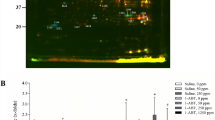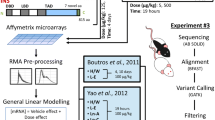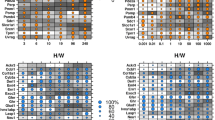Abstract
Dioxins cause various toxic effects through the aryl hydrocarbon receptor (AHR) in vertebrates, with dramatic species and strain differences in susceptibility. Although inbred mouse strains C3H/HeJ-lpr/lpr (C3H/lpr) and MRL/MpJ-lpr/lpr (MRL/lpr) are known as dioxin-sensitive and dioxin-resistant mice, respectively, the molecular mechanism underlying this difference remains unclear. The difference in the hepatic proteome of the two mouse strains treated with vehicle or 2,3,7,8-tetrabromodibenzo-p-dioxin (TBDD) was investigated by a proteomic approach of two-dimensional electrophoresis (2-DE) coupled with matrix-assisted laser desorption/ionization time-of-flight/time-of-flight tandem mass spectrometry (MALDI-TOF/TOF). To confirm the strain-difference in response to TBDD treatment, cytochrome P450 (CYP) 1A1 and 1A2 protein levels were measured in both strains. A dose of 10 µg/kg body weight of TBDD induced hepatic CYP1A1 and CYP1A2 expression in both strains, but the expression levels of both CYP1A proteins were higher in C3H/lpr mice than in MRL/lpr mice, supporting that C3H/lpr mice are more sensitive to dioxins than MRL/lpr mice. Proteins that were more induced or suppressed by TBDD treatment in C3H/lpr mice were successfully identified by 2-DE and MALDI-TOF/TOF, including proteins responsible for AHR activation through production of endogenous ligands such as aspartate aminotransferase, indolethylamine N-methyltransferase, and aldehyde dehydrogenases, as well as proteins reducing oxidative stress, such as superoxide dismutase and peroxiredoxins. Taken together, our results provide insights into the molecular mechanism underlying the high dioxin susceptibility of the C3H/lpr strain, in which AHR activation by TBDD is more prompted by the production of endogenous ligands, but the adaptation to oxidative stress is also acquired.







Similar content being viewed by others
References
Ao K, Suzuki T, Murai H et al (2009) Comparison of immunotoxicity among tetrachloro-, pentachloro-, tetrabromo- and pentabromo-dibenzo-p-dioxins in mice. Toxicology 256:25–31. doi:10.1016/j.tox.2008.10.024
Birnbaum LS, Staskal DF, Diliberto JJ (2003) Health effects of polybrominated dibenzo-p-dioxins (PBDDs) and dibenzofurans (PBDFs). Environ Int 29:855–860. doi:10.1016/S0160-4120(03)00106-5
Bittinger MA, Nguyen LP, Bradfield CA (2003) Aspartate aminotransferase generates proagonists of the aryl hydrocarbon receptor. Mol Pharmacol 64:550–556. doi:10.1124/mol.64.3.550
Boutros PC, Moffat ID, Franc MA et al (2004) Dioxin-responsive AHRE-II gene battery: identification by phylogenetic footprinting. Biochem Biophys Res Commun 321:707–715. doi:10.1016/j.bbrc.2004.06.177
Boverhof DR, Burgoon LD, Tashiro C et al (2005) Temporal and dose-dependent hepatic gene expression patterns in mice provide new insights into TCDD-Mediated hepatotoxicity. Toxicol Sci Off J Soc Toxicol 85:1048–1063. doi:10.1093/toxsci/kfi162
Boverhof DR, Burgoon LD, Tashiro C et al (2006) Comparative toxicogenomic analysis of the hepatotoxic effects of TCDD in Sprague Dawley rats and C57BL/6 mice. Toxicol Sci Off J Soc Toxicol 94:398–416. doi:10.1093/toxsci/kfl100
Cho S-W, Suzuki K, Miura Y et al (2015) Novel role of hnRNP-A2/B1 in modulating aryl hydrocarbon receptor ligand sensitivity. Arch Toxicol 89:2027–2038. doi:10.1007/s00204-014-1352-1
Chorley BN, Campbell MR, Wang X, et al (2012) Identification of novel NRF2-regulated genes by ChIP-Seq: influence on retinoid X receptor alpha. Nucleic Acids Res 40(15):7416–7429
Davidson WF, Giese T, Fredrickson TN (1998) Spontaneous development of plasmacytoid tumors in mice with defective fas–fas ligand interactions. J Exp Med 187:1825–1838
Denison MS, Heath-Pagliuso S (1998) The Ah receptor: a regulator of the biochemical and toxicological actions of structurally diverse chemicals. Bull Environ Contam Toxicol 61:557–568
Denison MS, Nagy SR (2003) Activation of the aryl hydrocarbon receptor by structurally diverse exogenous and endogenous chemicals. Annu Rev Pharmacol Toxicol 43:309–334. doi:10.1146/annurev.pharmtox.43.100901.135828
Denison MS, Fisher JM, Whitlock JP (1988) The DNA recognition site for the dioxin-Ah receptor complex. Nucleotide sequence and functional analysis. J Biol Chem 263:17221–17224
Dere E, Boverhof DR, Burgoon LD, Zacharewski TR (2006) In vivo–in vitro toxicogenomic comparison of TCDD-elicited gene expression in Hepa1c1c7 mouse hepatoma cells and C57BL/6 hepatic tissue. BMC Genom 7:80. doi:10.1186/1471-2164-7-80
Doncheva NT, Assenov Y, Domingues FS, Albrecht M (2012) Topological analysis and interactive visualization of biological networks and protein structures. Nat Protoc 7:670–685. doi:10.1038/nprot.2012.004
Ema M, Ohe N, Suzuki M et al (1994) Dioxin binding activities of polymorphic forms of mouse and human arylhydrocarbon receptors. J Biol Chem 269:27337–27343
Enright AJ, Dongen SV, Ouzounis CA (2002) An efficient algorithm for large-scale detection of protein families. Nucleic Acids Res 30:1575–1584. doi:10.1093/nar/30.7.1575
Esser C, Rannug A, Stockinger B (2009) The aryl hydrocarbon receptor in immunity. Trends Immunol 30:447–454. doi:10.1016/j.it.2009.06.005
Fernandez-Salguero PM, Hilbert DM, Rudikoff S et al (1996) Aryl-hydrocarbon receptor-deficient mice are resistant to 2,3,7,8-tetrachlorodibenzo-p-dioxin-induced toxicity. Toxicol Appl Pharmacol 140:173–179. doi:10.1006/taap.1996.0210
Furumatsu K, Nishiumi S, Kawano Y, et al (2011) A role of the aryl hydrocarbon receptor in attenuation of colitis. Dig Dis Sci 56(9):2532–2544
Guengerich FP (1982) Microsomal enzymes involved in toxicology: analysis and separation. In: Hayes AW (ed) Principles and methods of toxicology. Raven Press, New York, pp 609–634
Hornung MW, Zabel EW, Peterson RE (1996) Toxic equivalency factors of polybrominated dibenzo-p-dioxin, dibenzofuran, biphenyl, and polyhalogenated diphenyl ether congeners based on rainbow trout early life stage mortality. Toxicol Appl Pharmacol 140:227–234. doi:10.1006/taap.1996.0217
Itoh K, Chiba T, Takahashi S, et al (1997) An Nrf2/small Maf heterodimer mediates the induction of phase II detoxifying enzyme genes through antioxidant response elements. Biochem Biophys Res Commun 236(2):313–322
Iwata H, Yoshinari K, Negishi M, Stegeman JJ (2002) Species-specific responses of constitutively active receptor (CAR)-CYP2B coupling: lack of CYP2B inducer-responsive nuclear translocation of CAR in marine teleost, scup (Stenotomus chrysops). Comp Biochem Physiol Toxicol Pharmacol CBP 131:501–510
Jeong J, Kim Y, Kyung Seong J, Lee K-J (2012) Comprehensive identification of novel post-translational modifications in cellular peroxiredoxin 6. Proteomics 12:1452–1462. doi:10.1002/pmic.201100558
Jiang T, Tian F, Zheng H et al (2014) Nrf2 suppresses lupus nephritis through inhibition of oxidative injury and the NF-κB-mediated inflammatory response. Kidney Int 85:333–343. doi:10.1038/ki.2013.343
Kawakami T, Ishimura R, Nohara K et al (2006) Differential susceptibilities of Holtzman and Sprague-Dawley rats to fetal death and placental dysfunction induced by 2,3,7,8-teterachlorodibenzo-p-dioxin (TCDD) despite the identical primary structure of the aryl hydrocarbon receptor. Toxicol Appl Pharmacol 212:224–236. doi:10.1016/j.taap.2005.08.007
Mandal PK (2005) Dioxin: a review of its environmental effects and its aryl hydrocarbon receptor biology. J Comp Physiol [B] 175:221–230. doi:10.1007/s00360-005-0483-3
Mimura J, Yamashita K, Nakamura K et al (1997) Loss of teratogenic response to 2,3,7,8-tetrachlorodibenzo-p-dioxin (TCDD) in mice lacking the Ah (dioxin) receptor. Genes Cells Devoted Mol Cell Mech 2:645–654
Moffat ID, Boutros PC, Chen H et al (2010) Aryl hydrocarbon receptor (AHR)-regulated transcriptomic changes in rats sensitive or resistant to major dioxin toxicities. BMC Genom 11:263. doi:10.1186/1471-2164-11-263
Nakahama T, Kimura A, Nguyen NT, et al (2011) Aryl hydrocarbon receptor deficiency in T cells suppresses the development of collagen-induced arthritis. Proc Natl Acad Sci USA 108(34):14222–14227
Nebert DW, Roe AL, Dieter MZ et al (2000) Role of the aromatic hydrocarbon receptor and [Ah] gene battery in the oxidative stress response, cell cycle control, and apoptosis. Biochem Pharmacol 59:65–85
Nishihara M, Terada M, Kamogawa J et al (1999) Genetic basis of autoimmune sialadenitis in MRL/lpr lupus-prone mice: additive and hierarchical properties of polygenic inheritance. Arthritis Rheum 42:2616–2623. doi:10.1002/1529-0131(199912)42:12<2616:AID-ANR16>3.0.CO;2-O
Nordgren M, Fransen M (2014) Peroxisomal metabolism and oxidative stress. Biochimie 98:56–62. doi:10.1016/j.biochi.2013.07.026
Nose M (2007) A proposal concept of a polygene network in systemic vasculitis: lessons from MRL mouse models. Allergol Int 56:79–86. doi:10.2332/allergolint.R-04-140
Nose M, Nishimura M, Kyogoku M (1989) Analysis of granulomatous arteritis in MRL/Mp autoimmune disease mice bearing lymphoproliferative genes. The use of mouse genetics to dissociate the development of arteritis and glomerulonephritis. Am J Pathol 135:271–280
Oberemm A, Meckert C, Brandenburger L et al (2005) Differential signatures of protein expression in marmoset liver and thymus induced by single-dose TCDD treatment. Toxicology 206:33–48. doi:10.1016/j.tox.2004.06.061
Okey AB, Vella LM, Harper PA (1989) Detection and characterization of a low affinity form of cytosolic Ah receptor in livers of mice nonresponsive to induction of cytochrome P1-450 by 3-methylcholanthrene. Mol Pharmacol 35:823–830
Omura T, Sato R (1964) The carbon monoxide-binding pigment of liver microsomes. I. Evidence for its hemoprotein nature. J Biol Chem 239:2370–2378
Pastorelli R, Carpi D, Campagna R et al (2006) Differential expression profiling of the hepatic proteome in a rat model of dioxin resistance: correlation with genomic and transcriptomic analyses. Mol Cell Proteom MCP 5:882–894. doi:10.1074/mcp.M500415-MCP200
Poland A, Glover E (1990) Characterization and strain distribution pattern of the murine Ah receptor specified by the Ahd and Ahb-3 alleles. Mol Pharmacol 38:306–312
Poland A, Palen D, Glover E (1994) Analysis of the four alleles of the murine aryl hydrocarbon receptor. Mol Pharmacol 46:915–921
Quintana FJ, Basso AS, Iglesias AH et al (2008) Control of T(reg) and T(H)17 cell differentiation by the aryl hydrocarbon receptor. Nature 453:65–71. doi:10.1038/nature06880
Richard DM, Dawes MA, Mathias CW et al (2009) L-Tryptophan: basic metabolic functions, behavioral research and therapeutic indications. Int J Tryptophan Res 2:45–60
Sarioglu H, Brandner S, Haberger M et al (2008) Analysis of 2,3,7,8-tetrachlorodibenzo-p-dioxin-induced proteome changes in 5L rat hepatoma cells reveals novel targets of dioxin action including the mitochondrial apoptosis regulator VDAC2. Mol Cell Proteom MCP 7:394–410. doi:10.1074/mcp.M700258-MCP200
Schlezinger JJ, White RD, Stegeman JJ (1999) Oxidative activation of cytochrome P-450 1A (CYP1A) stimulated by 3,3′,4,4′-tetrachlorobiphenyl: production of reactive oxygen by vertebrate CYP1As. Mol Pharmacol 56:588–597. doi:10.1124/mol.56.3.588
Schlezinger JJ, William DJ. Struntz, Goldstone JV, Stegeman JJ (2006) Uncoupling of cytochrome P450 1A and stimulation of reactive oxygen species production by co-planar polychlorinated biphenyl congeners. Aquat Toxicol 77(4):422–432
Schrader M, Fahimi HD (2006) Peroxisomes and oxidative stress. Biochim Biophys Acta BBA—Mol Cell Res 1763:1755–1766. doi:10.1016/j.bbamcr.2006.09.006
Smirnova A, Wincent E, Vikström Bergander L et al (2016) Evidence for new light-independent pathways for generation of the endogenous aryl hydrocarbon receptor agonist FICZ. Chem Res Toxicol 29:75–86. doi:10.1021/acs.chemrestox.5b00416
Smith AG, Clothier B, Robinson S et al (1998) Interaction between iron metabolism and 2,3,7,8-tetrachlorodibenzo-p-dioxin in mice with variants of the Ahr gene: a hepatic oxidative mechanism. Mol Pharmacol 53:52–61. doi:10.1124/mol.53.1.52
Snel B, Lehmann G, Bork P, Huynen MA (2000) STRING: a web-server to retrieve and display the repeatedly occurring neighbourhood of a gene. Nucleic Acids Res 28:3442–3444
Starkov AA, Fiskum G (2001) Myxothiazol induces H(2)O(2) production from mitochondrial respiratory chain. Biochem Biophys Res Commun 281:645–650. doi:10.1006/bbrc.2001.4409
Steiner G, Skriner K, Smolen JS (1996) Autoantibodies to the A/B proteins of the heterogeneous nuclear ribonucleoprotein complex: novel tools for the diagnosis of rheumatic diseases. Int Arch Allergy Immunol 111:314–319
Sturla SJ, Boobis AR, FitzGerald RE et al (2014) Systems toxicology: from basic research to risk assessment. Chem Res Toxicol 27:314–329. doi:10.1021/tx400410s
Szklarczyk D, Franceschini A, Wyder S et al (2015) STRING v10: protein-protein interaction networks, integrated over the tree of life. Nucleic Acids Res 43:D447–D452. doi:10.1093/nar/gku1003
Takamura T, Harama D, Matsuoka S, et al (2010) Activation of the aryl hydrocarbon receptor pathway may ameliorate dextran sodium sulfate-induced colitis in mice. Immunol Cell Biol 88 (6):685–689
Thimmulappa RK, Mai KH, Srisuma S, et al (2002) Identification of Nrf2-regulated genes induced by the chemopreventive agent sulforaphane by oligonucleotide microarray. Cancer Res 62:5196–5203
van den Berg M, Denison MS, Birnbaum LS et al (2013) Polybrominated dibenzo-p-dioxins, dibenzofurans, and biphenyls: inclusion in the toxicity equivalency factor concept for dioxin-like compounds. Toxicol Sci Off J Soc Toxicol 133:197–208. doi:10.1093/toxsci/kft070
Viluksela M, Unkila M, Pohjanvirta R et al (1999) Effects of 2,3,7,8-tetrachlorodibenzo-p-dioxin (TCDD) on liver phosphoenolpyruvate carboxykinase (PEPCK) activity, glucose homeostasis and plasma amino acid concentrations in the most TCDD-susceptible and the most TCDD-resistant rat strains. Arch Toxicol 73:323–336. doi:10.1007/s002040050626
Vorderstrasse BA, Steppan LB, Silverstone AE, Kerkvliet NI (2001) Aryl hydrocarbon receptor-deficient mice generate normal immune responses to model antigens and are resistant to TCDD-induced immune suppression. Toxicol Appl Pharmacol 171:157–164. doi:10.1006/taap.2000.9122
Wang J, Duncan D, Shi Z, Zhang B (2013) WEB-based GEne SeT analysis toolkit (WebGestalt): update 2013. Nucleic Acids Res 41:W77–W83. doi:10.1093/nar/gkt439
Watanabe-Fukunaga R, Brannan CI, Copeland NG et al (1992) Lymphoproliferation disorder in mice explained by defects in Fas antigen that mediates apoptosis. Nature 356:314–317. doi:10.1038/356314a0
WHO/ICPS (1998) Polybrominated dibenzo-p-dioxins and dibenzofurans
Zelante T, Iannitti RG, Cunha C et al (2013) Tryptophan catabolites from microbiota engage aryl hydrocarbon receptor and balance mucosal reactivity via interleukin-22. Immunity 39:372–385. doi:10.1016/j.immuni.2013.08.003
Zhang N (2011) The role of endogenous aryl hydrocarbon receptor signaling in cardiovascular physiology. J Cardiovasc Dis Res 2:91–95. doi:10.4103/0975-3583.83033
Acknowledgments
This work was supported by Grants-in-Aid for Scientific Research (S) [No. 26220103] and Joint Research Project under the Japan–Korea Basic Scientific Cooperation Program for FY 2016 from Japan Society for the Promotion of Science (JSPS), which were given to Hisato Iwata. This study was also supported by the Ministry of Education, Culture, Sports, Science and Technology, Japan (MEXT), to a project on Joint Usage/Research Center—Leading Academia in Marine and Environmental Research (LaMer). Funding support was also given to E-Y. Kim from the National Research Foundation of Korea (NRF) grant funded by the Korea government (Ministry of Education, Science and Technology) [2016K2A9A2A08003746 and 2016R1A2B4007714].
Author information
Authors and Affiliations
Corresponding author
Ethics declarations
Conflict of interest
There is no conflict of interest.
Electronic supplementary material
Below is the link to the electronic supplementary material.
204_2016_1834_MOESM1_ESM.pdf
Fig. S1 Effects of TBDD exposure on body and organ weights in C3H/lpr and MRL/lpr mice. (A) Body weight of C3H/lpr and MRL/lpr mice was measured before and after three days of treatment with corn oil (control) or TBDD. (B) Relative liver, spleen, kidney, and thymus weights in control and TBDD-treated C3H/lpr and MRL/lpr mice. Fig. S3 Enlarged regions of the 2-DE gel images showing the spots of GPRIN1 (A), PDHA1 (B), and ASS1 (C) isoforms differentially expressed by TBDD exposure. Fig. S4 C3H/lpr network found by Network Analyzer (Cytoscape). Nodes with higher degree are displayed as a larger circle, while shades of red to green colors represent high to low betweenness centrality values for the node.(PDF 537 kb)
204_2016_1834_MOESM2_ESM.pdf
Fig. S2 Representative Coomassie Brilliant Blue-stained 2-DE gel images of protein (350 µg) extracted from representative liver microsomal (A) and cytosolic (B) fractions in vehicle-treated C3H/lpr, TBDD-treated C3H/lpr, vehicle-treated MRL/lpr, and TBDD-treated MRL/lpr mice (PDF 391 kb)
Rights and permissions
About this article
Cite this article
Nguyen, H.T., Tsuchiya, M.C.L., Yoo, J. et al. Strain differences in the proteome of dioxin-sensitive and dioxin-resistant mice treated with 2,3,7,8-tetrabromodibenzo-p-dioxin. Arch Toxicol 91, 1763–1782 (2017). https://doi.org/10.1007/s00204-016-1834-4
Received:
Accepted:
Published:
Issue Date:
DOI: https://doi.org/10.1007/s00204-016-1834-4




